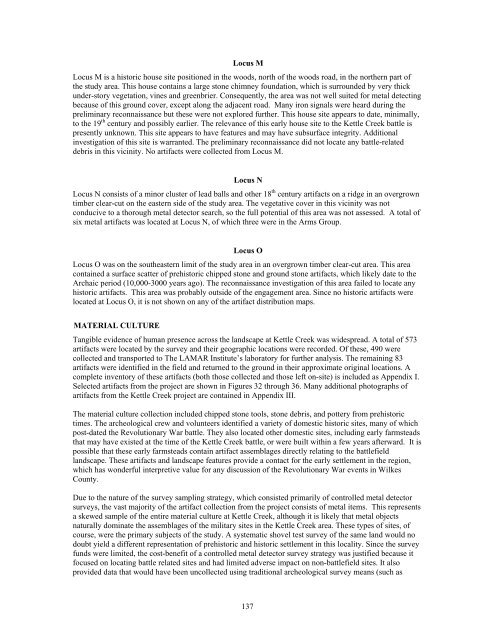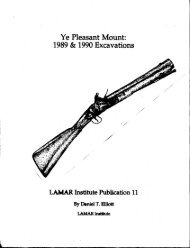Stirring Up a Hornet's Nest: - UGA Laboratory of Archaeology ...
Stirring Up a Hornet's Nest: - UGA Laboratory of Archaeology ...
Stirring Up a Hornet's Nest: - UGA Laboratory of Archaeology ...
You also want an ePaper? Increase the reach of your titles
YUMPU automatically turns print PDFs into web optimized ePapers that Google loves.
Locus M<br />
Locus M is a historic house site positioned in the woods, north <strong>of</strong> the woods road, in the northern part <strong>of</strong><br />
the study area. This house contains a large stone chimney foundation, which is surrounded by very thick<br />
under-story vegetation, vines and greenbrier. Consequently, the area was not well suited for metal detecting<br />
because <strong>of</strong> this ground cover, except along the adjacent road. Many iron signals were heard during the<br />
preliminary reconnaissance but these were not explored further. This house site appears to date, minimally,<br />
to the 19 th century and possibly earlier. The relevance <strong>of</strong> this early house site to the Kettle Creek battle is<br />
presently unknown. This site appears to have features and may have subsurface integrity. Additional<br />
investigation <strong>of</strong> this site is warranted. The preliminary reconnaissance did not locate any battle-related<br />
debris in this vicinity. No artifacts were collected from Locus M.<br />
Locus N<br />
Locus N consists <strong>of</strong> a minor cluster <strong>of</strong> lead balls and other 18 th century artifacts on a ridge in an overgrown<br />
timber clear-cut on the eastern side <strong>of</strong> the study area. The vegetative cover in this vicinity was not<br />
conducive to a thorough metal detector search, so the full potential <strong>of</strong> this area was not assessed. A total <strong>of</strong><br />
six metal artifacts was located at Locus N, <strong>of</strong> which three were in the Arms Group.<br />
Locus O<br />
Locus O was on the southeastern limit <strong>of</strong> the study area in an overgrown timber clear-cut area. This area<br />
contained a surface scatter <strong>of</strong> prehistoric chipped stone and ground stone artifacts, which likely date to the<br />
Archaic period (10,000-3000 years ago). The reconnaissance investigation <strong>of</strong> this area failed to locate any<br />
historic artifacts. This area was probably outside <strong>of</strong> the engagement area. Since no historic artifacts were<br />
located at Locus O, it is not shown on any <strong>of</strong> the artifact distribution maps.<br />
BMATERIAL CULTURE<br />
Tangible evidence <strong>of</strong> human presence across the landscape at Kettle Creek was widespread. A total <strong>of</strong> 573<br />
artifacts were located by the survey and their geographic locations were recorded. Of these, 490 were<br />
collected and transported to The LAMAR Institute’s laboratory for further analysis. The remaining 83<br />
artifacts were identified in the field and returned to the ground in their approximate original locations. A<br />
complete inventory <strong>of</strong> these artifacts (both those collected and those left on-site) is included as Appendix I.<br />
Selected artifacts from the project are shown in Figures 32 through 36. Many additional photographs <strong>of</strong><br />
artifacts from the Kettle Creek project are contained in Appendix III.<br />
The material culture collection included chipped stone tools, stone debris, and pottery from prehistoric<br />
times. The archeological crew and volunteers identified a variety <strong>of</strong> domestic historic sites, many <strong>of</strong> which<br />
post-dated the Revolutionary War battle. They also located other domestic sites, including early farmsteads<br />
that may have existed at the time <strong>of</strong> the Kettle Creek battle, or were built within a few years afterward. It is<br />
possible that these early farmsteads contain artifact assemblages directly relating to the battlefield<br />
landscape. These artifacts and landscape features provide a contact for the early settlement in the region,<br />
which has wonderful interpretive value for any discussion <strong>of</strong> the Revolutionary War events in Wilkes<br />
County.<br />
Due to the nature <strong>of</strong> the survey sampling strategy, which consisted primarily <strong>of</strong> controlled metal detector<br />
surveys, the vast majority <strong>of</strong> the artifact collection from the project consists <strong>of</strong> metal items. This represents<br />
a skewed sample <strong>of</strong> the entire material culture at Kettle Creek, although it is likely that metal objects<br />
naturally dominate the assemblages <strong>of</strong> the military sites in the Kettle Creek area. These types <strong>of</strong> sites, <strong>of</strong><br />
course, were the primary subjects <strong>of</strong> the study. A systematic shovel test survey <strong>of</strong> the same land would no<br />
doubt yield a different representation <strong>of</strong> prehistoric and historic settlement in this locality. Since the survey<br />
funds were limited, the cost-benefit <strong>of</strong> a controlled metal detector survey strategy was justified because it<br />
focused on locating battle related sites and had limited adverse impact on non-battlefield sites. It also<br />
provided data that would have been uncollected using traditional archeological survey means (such as<br />
137










